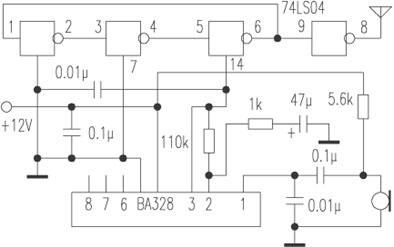Making wireless microphone and circuit with NAND gate circuit
Making wireless microphone and circuit with NAND gate circuit
Wireless microphones can be found everywhere on the market, but without exception, they are constructed with LC oscillators or quartz crystal oscillator circuits. As we all know, NAND gates have the effect of amplifying (referring to small signal conditions) and inverting, so as long as three NAND gates are connected end to end, a ring oscillator (or five, seven, nine, etc. odd numbers) is formed. ; The frequency is low when there are many stages), and it can also be made into a wireless microphone with frequency modulation circuit.
74L04 is a TTL integrated circuit with six single-ended input NAND gates. I use three of them to make an oscillator. When the power supply voltage is 5V, the oscillation frequency is about 90MHz. The frequency decreases when the power supply voltage decreases; the frequency also increases when the power supply voltage increases. Of course, the oscillation amplitude will also change accordingly, but the impact is not large. In this way, the author uses the method of changing the power supply voltage to change the frequency (that is, to achieve frequency modulation). The specific method is to use the output of an audio amplifier IC 328 as its power supply.
BA328 is an amplifying circuit for a recording head. When used for tape signal compensation and equalization, an RC series parallel network should be connected between the first pin and the pin, but here is used for linear amplification, so only one 100kΩ ~ 130kΩ Resistance is enough. The voltage at the output terminal (foot) of BA328 should be equal to one-half of the voltage at the foot (power supply). If the power supply voltage is 12V, there should be a 6V output. If it is not correct, adjust this resistance. In addition, the 1kΩ resistance in the figure is adjusted by the magnification, and the gain is increased when it is reduced.
When speaking to the electret microphone, the voltage at the output (foot) can change rapidly between 5.8V and 6.2V. This voltage can be sent to the 74LS04 pin to make it generate a frequency modulation signal, and then through the fourth Each NAND gate is amplified, isolated and sent to the antenna.
The power supply voltage of this wireless microphone can also be changed to 6V or 1.5V. In addition, its output power is small, readers can increase the level of high-frequency amplification to improve it. 
Dongguan Guancheng Precision Plastic Manufacturing Co., Ltd. , https://www.dpowergo.com